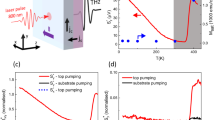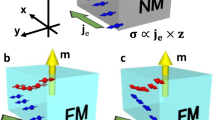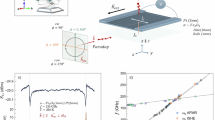Abstract
A particle current generated by pumping in the absence of gradients in potential energy, density or temperature1 is associated with non-trivial dynamics. A representative example is charge pumping that is associated with the quantum Hall effect2 and the quantum anomalous Hall effect3. Spin pumping, the spin equivalent of charge pumping, refers to the emission of a spin current by magnetization dynamics4,5,6,7. Previous studies have focused solely on transversal spin pumping arising from classical dynamics, which corresponds to precessing atomic moments with constant magnitude. However, longitudinal spin pumping arising from quantum fluctuations, which correspond to a temporal change in the atomic moment’s magnitude, remains unexplored. Here we experimentally investigate longitudinal spin pumping using iron–rhodium (FeRh), which undergoes a first-order antiferromagnet-to-ferromagnet phase transition during which the atomic moment’s magnitude varies over time. By injecting a charge current into a FeRh/platinum bilayer, we induce a rapid phase transition of FeRh in nanoseconds, leading to the emission of a spin current to the platinum layer. The observed inverse spin Hall signal is about one order of magnitude larger than expected for transversal spin pumping, suggesting the presence of longitudinal spin pumping driven by quantum fluctuations and indicating its superiority over classical transversal spin pumping. Our result highlights the significance of quantum fluctuations in spin pumping and holds broad applicability in diverse angular momentum dynamics, such as laser-induced ultrafast demagnetization8, orbital pumping9,10 and quantum spin transfer11,12,13.
This is a preview of subscription content, access via your institution
Access options
Access Nature and 54 other Nature Portfolio journals
Get Nature+, our best-value online-access subscription
27,99 € / 30 days
cancel any time
Subscribe to this journal
Receive 51 print issues and online access
199,00 € per year
only 3,90 € per issue
Buy this article
- Purchase on SpringerLink
- Instant access to full article PDF
Prices may be subject to local taxes which are calculated during checkout




Similar content being viewed by others
Data availability
The experimental and theoretical calculation data used in this paper are freely available at the Open Science Framework at https://doi.org/10.17605/OSF.IO/9p7q2. Source data are provided with this paper.
References
Citro, R. & Aidelsburger, M. Thouless pumping and topology. Nat. Rev. Phys. 5, 87–101 (2023).
Laughlin, R. B. Quantized Hall conductivity in two dimensions. Phys. Rev. B 23, 5632(R) (1981).
Kawamura, M. et al. Laughlin charge pumping in a quantum anomalous Hall insulator. Nat. Phys. 19, 333–337 (2023).
Tserkovnyak, Y., Brataas, A. & Bauer, G. E. W. Enhanced Gilbert damping in thin ferromagnetic films. Phys. Rev. Lett. 88, 117601 (2002).
Šimánek, E. Gilbert damping in ferromagnetic films due to adjacent normal-metal layers. Phys. Rev. B 68, 224403 (2003).
Mizukami, S., Ando, Y. & Miyazaki, T. Ferromagnetic resonance linewidth for NM/80NiFe/NM films (NM=Cu, Ta, Pd and Pt). J. Magn. Magn. Mater. 226, 1640–1642 (2001).
Urban, R., Woltersdorf, G. & Heinrich, B. Gilbert damping in single and multilayer ultrathin films: role of interfaces in nonlocal spin dynamics. Phys. Rev. Lett. 87, 217204 (2001).
Beaurepaire, E., Merle, J.-C., Daunois, A. & Bigot, J.-Y. Ultrafast spin dynamics in ferromagnetic nickel. Phys. Rev. Lett. 76, 4250–4253 (1996).
Hayashi, H., Go, D., Haku, S., Mokrousov, Y. & Ando, K. Observation of orbital pumping. Nat. Electron. 7, 646–652 (2024).
Han, S. et al. Orbital pumping incorporating both orbital angular momentum and position. Preprint at https://arxiv.org/abs/2311.00362 (2023).
Zholud, A., Freeman, R., Cao, R., Srivastava, A. & Urazhdin, S. Spin transfer due to quantum magnetization fluctuations. Phys. Rev. Lett. 119, 257201 (2017).
Mitrofanov, A. & Urazhdin, S. Nonclassical spin transfer effects in an antiferromagnet. Phys. Rev. Lett. 126, 037203 (2021).
Petrović, M. D., Mondal, P., Feiguin, A. E. & Nikolić, B. K. Quantum spin torque driven transmutation of an antiferromagnetic Mott insulator. Phys. Rev. Lett. 126, 197202 (2021).
Slonczewski, J. C. Current-driven excitation of magnetic multilayers. J. Magn. Magn. Mater. 159, L1–L7 (1996).
Berger, L. Emission of spin waves by a magnetic multilayer traversed by a current. Phys. Rev. B 54, 9353–9358 (1996).
Saitoh, E., Ueda, M., Miyajima, H. & Tatara, G. Conversion of spin current into charge current at room temperature: inverse spin-Hall effect. Appl. Phys. Lett. 88, 182509 (2006).
Mosendz, O. et al. Detection and quantification of inverse spin Hall effect from spin pumping in permalloy/normal metal bilayers. Phys. Rev. B 82, 214403 (2010).
Nakayama, H. et al. Geometry dependence on inverse spin Hall effect induced by spin pumping in Ni81Fe19/Pt films. Phys. Rev. B 85, 144408 (2012).
Wang, H. L. et al. Scaling of spin Hall angle in 3d, 4d, and 5d metals from Y3Fe5O12/metal spin pumping. Phys. Rev. Lett. 112, 197201 (2014).
Uchida, K. et al. Observation of the spin Seebeck effect. Nature 455, 778–781 (2008).
Fallot, M. Les alliages du fer avec les métaux de la famille du platine. Ann. Phys. 11, 291–332 (1938).
Maat, S., Thiele, J.-U. & Fullerton, E. E. Temperature and field hysteresis of the antiferromagnetic-to-ferromagnetic phase transition in epitaxial FeRh films. Phys. Rev. B 72, 214432 (2005).
Barker, J. & Chantrell, R. W. Higher-order exchange interactions leading to metamagnetism in FeRh. Phys. Rev. B 92, 094402 (2015).
Stamm, C. et al. Antiferromagnetic-ferromagnetic phase transition in FeRh probed by X-ray magnetic circular dichroism. Phys. Rev. B 77, 184401 (2008).
Koenig, C. Self-consistent band structure of paramagnetic, ferromagnetic and antiferromagnetic ordered FeRh. J. Phys. F 12, 1123 (1982).
Sandratskii, L. M. & Mavropoulos, P. Magnetic excitations and femtomagnetism of FeRh: a first-principles study. Phys. Rev. B 83, 174408 (2011).
Kouvel, J. S. & Hartelius, C. C. Anomalous magnetic moments and transformations in the ordered alloy FeRh. J. Appl. Phys. 33, 1343 (1962).
Wang, Y. et al. Spin pumping during the antiferromagnetic–ferromagnetic phase transition of iron–rhodium. Nat. Commun. 11, 275 (2020).
Nan, T. et al. Electric-field control of spin dynamics during magnetic phase transitions. Sci. Adv. 6, eabd2613 (2020).
Marti, X. et al. Room-temperature antiferromagnetic memory resistor. Nat. Mater. 13, 367–374 (2014).
Kovalev, A. A., Bauer, G. E. W. & Brataas, A. Perpendicular spin valves with ultrathin ferromagnetic layers: magnetoelectronic circuit investigation of finite-size effects. Phys. Rev. B 73, 054407 (2006).
Bass, J. & Pratt, W. P. Spin-diffusion lengths in metals and alloys, and spin-flipping at metal/metal interfaces: an experimentalist’s critical review. J. Phys. Condens. Matter 19, 183201 (2007).
Grazhdankina, N. P. Magnetic first order phase transitions. Sov. Phys. Usp. 11, 727–745 (1969).
Fruchart, D. & Bertaut, E. F. Magnetic studies of the metallic perovskite-type compounds of manganese. J. Phys. Soc. Jpn 44, 781–791 (1978).
Atxitia, U. et al. Micromagnetic modeling of laser-induced magnetization dynamics using the Landau-Lifshitz-Bloch equation. Appl. Phys. Lett. 91, 232507 (2007).
Carpene, E., Hedayat, H., Boschini, F. & Dallera, C. Ultrafast demagnetization of metals: collapsed exchange versus collective excitations. Phys. Rev. B 91, 174414 (2015).
Koopmans, B. et al. Explaining the paradoxical diversity of ultrafast laser-induced demagnetization. Nat. Mater. 9, 259–265 (2010).
Battiato, M., Carva, K. & Oppeneer, P. M. Superdiffusive spin transport as a mechanism of ultrafast demagnetization. Phys. Rev. Lett. 105, 027203 (2010).
Mueller, B. Y. et al. Feedback effect during ultrafast demagnetization dynamics in ferromagnets. Phys. Rev. Lett. 111, 167204 (2013).
Turgut, E. et al. Stoner vs. Heisenberg: ultrafast exchange reduction and magnon generation during laser-induced demagnetization. Phys. Rev. B 94, 220408(R) (2016).
Go, D. & Lee, H.-W. Orbital torque: torque generation by orbital current injection. Phys. Rev. Res. 2, 013177 (2020).
Lee, D. et al. Orbital torque in magnetic bilayers. Nat. Commun. 12, 6710 (2021).
Sala, G. & Gambardella, P. Giant orbital Hall effect and orbital-to-spin conversion in 3d, 5d, and 4f metallic heterostructures. Phys. Rev. Res. 4, 033037 (2022).
Bruno, P. Tight-binding approach to the orbital magnetic moment and magnetocrystalline anisotropy of transition-metal monolayers. Phys. Rev. B 39, 865(R) (1989).
Zhang, L. & Niu, Q. Angular momentum of phonons and the Einstein–de Haas effect. Phys. Rev. Lett. 112, 085503 (2014).
Holanda, J., Maior, D. S., Azevedo, A. & Rezende, S. M. Detecting the phonon spin in magnon–phonon conversion experiments. Nat. Phys. 14, 500–506 (2018).
Hamada, M., Minamitani, E., Hirayama, M. & Murakami, S. Phonon angular momentum induced by the temperature gradient. Phys. Rev. Lett. 121, 175301 (2018).
Streib, S., Keshtgar, H. & Bauer, G. E. W. Damping of magnetization dynamics by phonon pumping. Phys. Rev. Lett. 121, 027202 (2018).
Schlitz, R. et al. Magnetization dynamics affected by phonon pumping. Phys. Rev. B 106, 014407 (2022).
Ishito, K. et al. Truly chiral phonons in α-HgS. Nat. Phys. 19, 35–39 (2023).
Chen, K. & Zhang, S. Spin pumping in the presence of spin–orbit coupling. Phys. Rev. Lett. 114, 126602 (2015).
Yu, C. Q. et al. Thickness-dependent magnetic order and phase-transition dynamics in epitaxial Fe-rich FeRh thin films. Phys. Lett. A 383, 2424 (2019).
Wang, Y., Deorani, P., Qiu, X., Kwon, J. H. & Yang, H. Determination of intrinsic spin Hall angle in Pt. Appl. Phys. Lett. 105, 152412 (2014).
Stamm, C. et al. Magneto-optical detection of the spin Hall effect in Pt and W thin films. Phys. Rev. Lett. 119, 087203 (2017).
Wang, L. et al. Giant room temperature interface spin Hall and inverse spin Hall effects. Phys. Rev. Lett. 116, 196602 (2016).
Tao, X. et al. Self-consistent determination of spin Hall angle and spin diffusion length in Pt and Pd: the role of the interface spin loss. Sci. Adv. 4, eaat1670 (2018).
Lee, J.-S., Vescovo, E., Plucinski, L., Schneider, C. M. & Kao, C.-C. Electronic structure and magnetic properties of epitaxial FeRh(001) ultrathin films on W(100). Phys. Rev. B 82, 224410 (2010).
Núñez, A. S., Duine, R. A., Haney, P. & MacDonald, A. H. Theory of spin torques and giant magnetoresistance in antiferromagnetic metals. Phys. Rev. B 73, 214426 (2006).
Yu, J. et al. Long spin coherence length and bulk-like spin–orbit torque in ferrimagnetic multilayers. Nat. Mater. 18, 29–34 (2019).
Slater, J. C. & Koster, G. F. Simplified LCAO method for the periodic potential problem. Phys. Rev. 94, 1498–1524 (1954).
Luisier, M., Schenk, A., Fichtner, W. & Klimeck, G. Atomistic simulation of nanowires in the sp3d5s* tight-binding formalism: from boundary conditions to strain calculations. Phys. Rev. B 74, 205323 (2006).
Acknowledgements
We acknowledge discussion with G.-M. Choi, H.-S. Lee, E.-G. Moon and Y. Kim. M.-H.J. acknowledges the support from the National Research Foundation of Korea (NRF) (2020R1A2C3008044 and 2022R1A4A1033562) and Samsung Electronics Co., Ltd (202470076.08). K.-J.K. acknowledges the support from the NRF (RS-2023-00275259 and RS-2023-00207732), Technology Innovation Program (20020286) by the Ministry of Trade, Industry and Energy of Korea and Korea Semiconductor Research Consortium, and Samsung Research Funding Center of Samsung Electronics (SRFC-MA2002-02). K.-J.L. acknowledges the support from the NRF (2022M3H4A1A04096339, 2020R1A2C3013302, and 2022R1A4A103134911), Samsung Research Funding Center of Samsung Electronics (SRFCMA1702-02), and Samsung Electronics Co., Ltd (IO201019-07699-01). H.-W.L. acknowledges the support from the NRF (RS-2024-00410027). S.K.K. acknowledges the support from the NRF (grant numbers 2020H1D3A2A03099291 and 2021R1C1C1006273).
Author information
Authors and Affiliations
Contributions
T.L., S.K. and K.-J.K. designed the experimental set-up and performed the measurements and data collection. M.T.P. and M.-H.J. performed the deposition of high-quality FeRh films and characterized their properties. H.-W.K., J.H.O., S.H., J.G.J., G.-W.B., S.K.K., H.-W.L. and K.-J.L. carried out theoretical and numerical study on spin pumping. All authors performed the data analysis and result discussion and contributed to the paper preparation.
Corresponding authors
Ethics declarations
Competing interests
The authors declare no competing interests.
Peer review
Peer review information
Nature thanks Sergei Urazhdin and the other, anonymous, reviewer(s) for their contribution to the peer review of this work. Peer reviewer reports are available.
Additional information
Publisher’s note Springer Nature remains neutral with regard to jurisdictional claims in published maps and institutional affiliations.
Extended data figures and tables
Extended Data Fig. 1 Geometry of samples.
Atomic force microscope (AFM) image of FeRh/Pt (left) and FeRh/Ta (right).
Extended Data Fig. 2 Dependence of inverse spin Hall voltage on the magnetic field angle.
a, Vodd profile obtained for specific field angles. b, Peak area as a function of magnetic field angle.
Extended Data Fig. 3 Dependence of resistance change and inverse spin Hall voltage on the current polarity.
a, VOSC profile for positive (black) and negative (green) magnetic fields when positive current is injected. It is important to note that distinguishing the difference in VOSC between positive and negative fields is challenging from VOSC versus time plot, as explained in Supplementary Note S3. b, Resistance variation obtained from the VOSC profile. c, Subtracted signal \({V}_{{odd}}=\{{V}_{{OSC}}(+H)-{V}_{{OSC}}(-H)\}/2\). The gray line indicates the time when the phase transition occurs. d-f, same as a-c obtained for a negative current. The results are obtained from FeRh (170 nm)/Pt (5 nm).
Extended Data Fig. 4 Magnetic field dependence of peak area and emitted spin quantity.
a, Area \({A}_{{Vt}}[=\int {dt}{V}_{{odd}}(t)]\) of peak ISHE voltage as a function of the field (Hy). b, The amount of emitted spin per unit area (∆SSP) from FeRh to Pt, calculated from a.
Extended Data Fig. 5 Two-macrospin simulation results.
a, Time evolution of transversal spin pumping current \({j}_{s}^{\perp }\) at various external fields \(({\mu }_{0}{H}_{y}\ge 90\,{\rm{mT}})\). b, Time evolution of \({j}_{s}^{\perp }\) and angle θ between two sublattice moments at μ0Hy = 200 mT. Grey area of b represents standard deviations of \({j}_{s}^{\perp }\).
Extended Data Fig. 6 Tight-biding model.
Schematic of NM/FM(tFM)/NM system. The FM is sandwiched between two semi-infinite NM contacts and each part is constructed with a layer periodic over the y direction. Boxed area denotes bcc unit cells composing the layer.
Supplementary information
Supplementary Information
Supplementary Notes 1–10, Figs. 1–15, Tables 1 and 2, and References.
Rights and permissions
Springer Nature or its licensor (e.g. a society or other partner) holds exclusive rights to this article under a publishing agreement with the author(s) or other rightsholder(s); author self-archiving of the accepted manuscript version of this article is solely governed by the terms of such publishing agreement and applicable law.
About this article
Cite this article
Lee, T., Park, M.T., Ko, HW. et al. Signatures of longitudinal spin pumping in a magnetic phase transition. Nature 638, 106–111 (2025). https://doi.org/10.1038/s41586-024-08367-z
Received:
Accepted:
Published:
Issue Date:
DOI: https://doi.org/10.1038/s41586-024-08367-z



